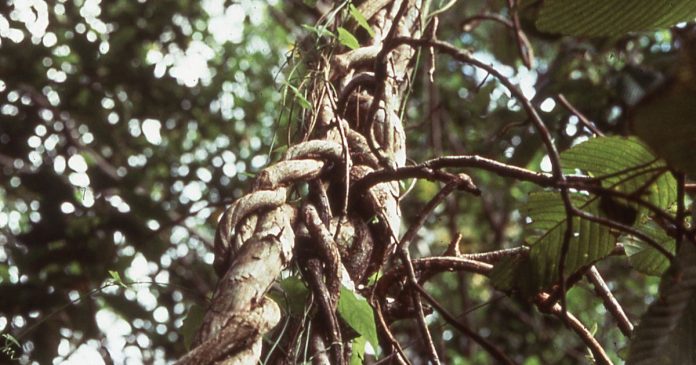Relieving trees of their burden with woody vines (lianas) is an extremely cost-effective way to improve the economic value of managed forests and help mitigate climate change, according to a new study conducted by University of Florida scientists in Forest Ecology and Management has been published. The Nature Conservancy, Conservation International and partner institutions.
The paper shows that strategic vine cutting, especially in selectively logged forests, can significantly increase timber production and give forest managers access to voluntary carbon markets. To minimize the impact on biodiversity, the authors recommend limiting the number of trees stripped of lianas and propose a detailed approach to applying the treatment, monitoring and carbon crediting.
Climate change and other human disturbances are causing woody infestations to increase, particularly in forests exposed to selective logging. While lianas are fundamental components of most tropical and some temperate forest ecosystems, they reduce tree survival and growth rates, reducing timber yields in managed forests and reducing carbon sequestration where they are abundant. Conversely, dozens of previous experimental studies document that tree growth rates often double in response to vine removal.
A “low-hanging” natural climate solution
An estimated 250 million hectares of selectively logged forests worldwide are affected by lianas. The authors calculated that the release of just five future crop trees (FCTs) — or trees designated for harvest — per hectare in these managed forests would remove 800 million tons of carbon dioxide (CO2) from the atmosphere over a 30-year period would.
“Lianas are great, but they are also strong competitors with trees above and below ground,” says senior author Jack Putz, who continues his research at Australia’s University of the Sunshine Coast.
“Particularly in selectively logged forests, cutting lianas on selected future trees would help maintain timber yields while having minimal impact on biodiversity. In forests not designated for logging, cutting vines could increase tree fruit production while increasing carbon removal from the atmosphere.”
Vine cutting is easily integrated into existing forest management practices and the cost of the treatment is estimated to be less than $1.00 per tonne of CO2. This represents an attractive opportunity for countries to both meet their climate targets or Nationally Determined Contributions (NDCs) and – given current carbon market prices of USD 10-20 per tonne of CO2 – increase the economic potential of selectively logged forests.
“At a time when the impacts of forest carbon projects are being questioned more than ever, comes liana removal, a novel and cost-effective approach to mitigating climate change that preserves the ecological integrity of forest ecosystems,” says Alex Finkral, Forest Investment Manager and President and CEO of Eastwood Forests.
“Liana projects in high biodiversity environments will generate high quality carbon credits that will command price premiums.”
It is important to note that lianas provide important ecosystem services, act as intercanopy pathways for non-flying canopy animals, and are some important food sources for wildlife. To minimize the trade-off between forest biodiversity and tree growth, the authors recommend stripping no more than ten trees per hectare of their vine load and leaving vines in the remaining trees untouched. Any impacts on biodiversity should also be considered in the broader context of conservation benefits; Keeping managed forests economically viable helps prevent their conversion to non-forest land uses.
Co-author Denver Cayetano, a Belizean forest biologist and Ph.D. University of Florida student says this is a low-cost and easy-to-implement natural climate solution based on traditional knowledge that can also benefit local communities looking to participate in carbon markets.
“Most CO2 projects require large upfront investments,” he says, “while in this case owners of small patches of forest can free up a few trees and thereby contribute to climate protection.”
Natural climate solutions — activities to protect, restore, and improve the management of forests and other natural ecosystems so they can absorb and store more carbon — are a critical part of addressing the climate crisis. Recent studies by the Nature Conservancy and others show that restoring and protecting nature could deliver up to a third of the emission reductions needed by 2030, capturing up to 11 billion tons of CO2 annually. Most of this emission reduction would come from forest interventions, particularly in Latin America, Africa and Southeast Asia.
“Smart removal of lianas in managed forests is a climate no-brainer with a double win for the climate at a cost of pennies per tonne of carbon,” says study co-author Peter Ellis, Global Director of Natural Climate Solutions Science at The Nature Conservancy.
“If you’re looking for a ready-to-use ‘low hanging’ natural climate solution, I can’t think of a better option.”
Selective liana pruning is an extremely cost-effective solution to the natural climate and a profitable forestry intervention that should be standard in managed forests where liana infestations are prevalent. The authors are now working with voluntary carbon market programs such as the Verified Carbon Standard (VCS) to create a streamlined carbon accounting process so that this climate positive strategy for improved forest management can soon be implemented.
“Liana thinning can restore forests, improve local livelihoods and help reverse climate change,” said Bronson Griscom, Conservation International’s vice president of natural climate solutions.
“We have been damaging forests and pumping CO2 into the atmosphere for centuries. Both activities have given vines an advantage over trees and limited forests’ ability to absorb CO2 from the atmosphere. It’s time to flip the script.”
www.nature.org
https://www.nature.org/en-us/newsroom/liana-liberation/














